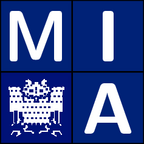
Complementary Optic Flow on the GPU
Home
About Us
People
Teaching
Research
Publications
Awards
Links
Contact
Internal
Numerics
Fast Explicit Diffusion (FED)
Like all variational approaches, our model requires the solution of huge
systems of equations to obtain an optimal solution. Consequently, this part
typically constitutes the most expensive part of the algorithm and is thus
crucial for its overall run-time.
Thus, we use a solver recently proposed by Grewenig et al.
[1]. This so-called Fast Explicit Diffusion (FED) is a
general-purpose solver for diffusion-like processes. It is based on an explicit
scheme, but uses varying mathematically founded time steps. About half of
them exceed the stability bound for explicit schemes, while the other half is
below this limit. By this construction, one can show unconditional stability
for the whole process.

A stable series of steps forms one linear cycle with a certain stopping
time. If one considers a non-linear problem (like our optic flow approach),
these cycles can easily be combined with a lagged diffusivities framework:
To ensure stability, the update of the diffusivity or the diffusion tensor is
only implemented at the beginning of each cycle.
In order to accelerate the convergence of this process even further, we embed
our FED solver in a coarse-to-fine strategy. This means, we first recursively
compute the solution for a downsampled version of the problem, and use the
upsampled solution as an initialisation for the next finer level.
With these simple ingredients — a basic explicit solver within a
coarse-to-fine strategy — we obtain framerates comparable to
those of modern bi-directional full multigrid (FAS) solvers. Still, the effort
to implement this framework is fairly moderate on both a CPU and a GPU.
A library that computes the specific step sizes for FED is available as free software and can be downloaded on our research pages.
References:
| [1] |
S. Grewenig, J. Weickert, A. Bruhn: From box filtering to fast explicit diffusion. In Pattern Recognition, Proc. 32th DAGM Symposium DAGM 2010, Darmstadt, Germany, September 2010. Lecture Notes in Computer Science, Vol. 6376, 533-542, Springer, Berlin, 2010. |
MIA Group
©2001-2023
The author is not
responsible for
the content of
external pages.
Imprint -
Data protection